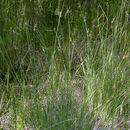Brief Summary
provided by EOL authors
Carex serratodens has a distribution within California, Arizona and Oregon in the western USA. Habitats include moist places on open hillsides, adjacent to springs, seeps, or riparian zones within an altitude range of 100 to 1400 meters. In some cases this plant is found in the specialized habitat of serpentine seeps, where it is sometimes accompanied by a number of rare plants.
This species has a tufted growth form and rises to a height no exceeding 75 centimeters; upper parts of the culm are scabrous (rough to the touch).
Comprehensive Description
provided by North American Flora
Carex serratodens W. Boott, in S. Wats. Bot. Calif
2:245. 1880.
Carex bifida Boott; Olney, Proc. Am. Acad. 7: 394. 1868. (Type from Salinas Valley, south of Monterey, California.) Not C. bifida Roth; Steud. Nom. ed. 1. 155. 1821.
Carex aequa C. B. Clarke, Kew Bull. Add. Ser. 8: 86. 1908. (Type from San Mateo County, California.)
Loosely cespitose with short, ascending stolons, the culms 3-12 dm. high, slender, sharply triangular, smooth or roughened immediately beneath spikes, papillose, exceeding the leaves, aphyllopodic and strongly purplish-tinged at base, the basal sheaths breaking and becoming filamentose; sterile shoots strongly phyllopodic, very conspicuous; leaves with well-developed blades 2-5 to a fertile culm, clustered on lower fourth, the blades 1-6 dm. long, 1.75-4 mm. wide, flat, pale-green, papillose, slender, long-attenuate, roughened towards apex, not septatenodulose, the sheaths very thin and dull-white-hyaline or yellowish-brown-tinged and reddotted ventrally, the ligule strongly red-dotted, as long as wide; terminal spike staminate or gynaecandrous, slightly peduncled or nearly sessile, linear, 1.5-3 cm. long, 3-4.5 mm. wide, the scales oblong-obovate, from roughly short mucronate to obtuse, reddish-brown with lighter center and slightly hyaline apex; pistillate spikes 2-5, the lower 1 or 2 more or less separate, the others closely approximate, erect, sessile or the lowest slightly peduncled, oblong, 6-18 mm. long, 5-8 mm. wide, densely flowered, containing 20-40 ascending and at length spreading or squarrose perigynia in many rows; lowest bract leaflet-like, erect, from shorter than to exceeding culm, scarcely sheathing, purplish-tinged at base; the other bracts much reduced; scales ovate, acute to shortly rough-mucronate, somewhat narrower and slightly shorter than perigynia, reddish-brown with lighter center; perigynia oblong-ovate or ovate, flattened-triangular in cross-section, 3-5 mm. long, 1.5-2 mm. wide, many (about 10)nerved, light-green, purplish-dotted, puncticulate, the walls thin, round-contracted and sessile at base, rather abruptly tapering at apex into the slender bidentate rough beak 0.5-1 mm. long, the notch narrow, the teeth erect, minute, hispidulous and purplish-tinged within; achenes obtusely triangular, obovoid, 2 mm. long, 1.5 mm. wide, loosely enveloped, in lower half of perigynium, short-stipitate, abruptly slenderly apiculate, jointed with the straight slender style; stigmas 3, reddish-brown, slender, short.
Type locality: California, without locality or collector being given.
Distribution: Open places, Jackson County, Oregon, and southward in California, mostly in the Coast Ranges, to San Bernardino County. (Specimens examined from range as given.)
- bibliographic citation
- Kenneth Kent Mackenzie. 1935. (POALES); CYPERACEAE; CARICEAE. North American flora. vol 18(6). New York Botanical Garden, New York, NY

